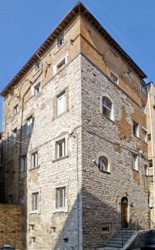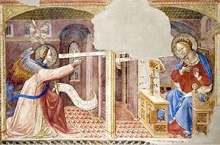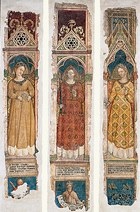


This palace was documented in the 19th century, when most of its important frescoes were detached (see below). More recent descriptions usually allege that it was subsequently demolished. However, Francesco Federico Mancini (referenced below) has identified it as this palace at 30 Piazza Morlacchi (on the corner with Via della Pernice).
The palace on this site belonged to Francesco di Berardo della Corgna in 1361. On his death in 1404, it passed to his son, Corniolo della Corgna. In more recent times, it has belonged to the Bassardini-Seppi-Isidori and the Stocchi and families.
The palace was documented as “unum palatium cum una logia” (a palace with a loggia) in 1500: traces of the loggia can be seen in the brick walls of the two upper storeys, which were added in the late 15th century. In the older part of the palace:
-
✴the first floor includes the room with the frescoes (below); and
-
✴the basement includes a room that retains its original Gothic vaults.
The main entrance was moved into Piazza Morlacchi and the double staircase was built in front of it in the 19th century.
The palace was still in private ownership in 1894 (see below), but is now part of the University of Perugia.
Frescoes (ca. 1390 ?)
The frescoes in a room on the first floor of the palace were documented in 1871, when the then owner, Francesco Bassardini, informed the Mayor of Perugia that he wished to have them detached and sold to the city. Nothing happened until 1889, when the city commissioned an assessment of the works from three experts:
-
✴Luigi Carattoli, Director of the Accademia di Belle Arti;
-
✴Francesco Moretti, Director of the Galleria Civica; and
-
✴the artist and art restorer, Matteo Tassi.
This investigation did not lead to a purchase offer from the city, and most of the frescoes were detached and sold through intermediaries to the Szépművészeti Múzeum, Budapest in 1894.
There are two main hypotheses as to the date and attribution of the frescoes:
-
✴The frescoes have generally been dated to ca. 1380 on stylistic grounds and attributed to Cola Petruccioli. This implies that they were commissioned by Francesco di Berardo della Corgna.
-
✴However, Francesco Federico Mancini (referenced below) suggested that they were more probably painted shortly after 1416, when the nobles of Perugia were able to return to Perugia after a period of almost continuous exile that had begun in 1378. He therefore deduced that Corniolo della Corgna must have commissioned them from Policleto di Cola, the son of Cola Petruccioli and the inheritor of his workshop.
More recently, Corrado Fratini (referenced below) has argued that the frescoes in Palazzo Stocchi-Isidori owe nothing to a number of influential works executed in the region by leading artists in the early 15th century (such as, for example, the frescoes (1411-12) by Gentile da Fabriano and his associates in Palazzo Trinci, Foligno and the panel (ca. 1410) by the same artist in San Domenico, Perugia). He therefore favours the earlier dating and the attribution to Cola Petruccioli. He suggests that the work could have been commissioned in 1389-93, when it was the turn of the “popolo grasso” (the enemies of the nobles) to face exile.
Annunciation on a side wall

This fresco from the wall, which was transferred onto canvas before its transfer to Budapest in 1894, has recently been restored. It is set in a Gothic interior, in which a kneeling angel brings the message to Mary as she sits in front of a lectern. Unfortunately, the part of the composition, in which a dove representing the Holy Spirit would have been depicted, has been lost.
Virtues and Vices

-
✴The allegory of the “Sapientia Domini” (Wisdom of God), which seems to have been the most important, was probably sited directly above the Annunciation (above).
-
✴The three Virtues illustrated here, which are among the best-preserved, depict (from the left): Fortitude; Justice; and the Active Life.
-
✴The other identifiable Virtues comprise: Faith; Hope; Charity; Love; Prudence; Temperance; and the Contemplative Life.
-
✴The two identifiable Vices are: Prodigality; and Avarice.
Labours of Hercules
The surviving fragments of this cycles, which were discovered in situ on the walls in 1993, were apparently covered by plaster and thus undetected in 1889-94. They have recently been restored.
Read more:
A. Dunlop, “Painted Palaces”, (2009) Pennsylvania, pp. 110-1 and p248, note 26
C. Fratini; “Su Alcuni Cicli Pittorici Profani del Tardo Medioevo in Umbria”, in:
M. Nico Ottaviani, “Rocche e Fortificazioni nello Stato della Chiesa”, pp 255-268
I. Fehér, “Cola Petruccioli's Fresco Cycle from Palazzo Isidori, Perugia”, Arte Cristiana, 95 (2007) pp. 111-120
I. Fehér, “Il Ciclo di Affreschi Allegorici del Palazzo Isidori, Perugia alla Luce delle Ultime Ricerche e Restauri”, Bulletin du Musée Hongrois des Beaux-Arts, 92/93 (2000) pp. 1 179-188
F. Mancini, “La Formazione di Benedetto Bonfigli”, in
M. Cianini Pierotti (Ed.), “Benedetto Bonfigli e il suo Tempo: Atti del Convegno, Perugia, 21-2 febbraio 1997”, (1998) Perugia pp. 61-5
Return to Monuments of Perugia.
Return to: Walk II.

